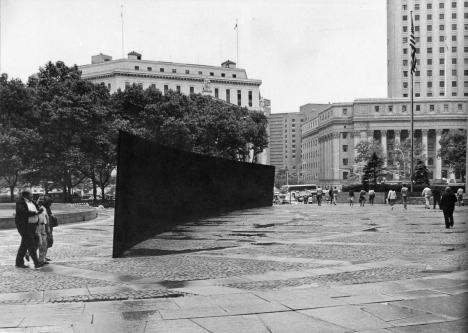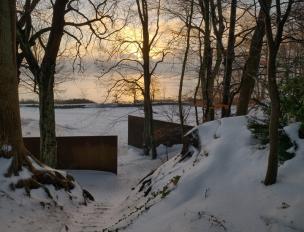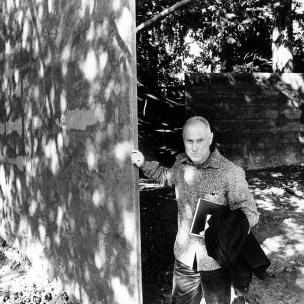
WHEN ART GETS IN THE WAY
Richard Serra’s works are hard to miss: They affect both us and the place where they are situated because we can feel in our bodies that they are there and they intervene with our surroundings.
A visit to Louisiana
Serra has created a work specifically for Louisiana. It consists of two large sheets of corten steel. It is set up in a gorge in the park surrounding the museum. There is a space between the two sheets that allows you to pass between them, but not without zigzagging a bit. The sheets are situated so that they form a gateway between the lawn extending to the beach and the stairway up to the rest of the park and Bed of Ferns. Depending on where you stand, the view of either the stairway or the lawn and the sea is blocked by the gate until you go through it. If you come from the stairway heading down toward the water, the sensation of walking on a dark forest floor through a gorge will slowly give way to an experience of light and the view across the Øresund, which might seem more impressive because it has been long in coming. A visit to Louisiana is about experiencing art. It therefore does not seem disturbing when The Gate in the Gorge slows our pace a bit. When we are in a city, on the other hand, we often walk toward a specific objective, and we want to move from one place to another with as few obstacles as possible. We therefore do not have the same interest in being hindered in order to perceive our surroundings more intensively.
 Tilted Arc in New York. Photo: Susan Swider
Tilted Arc in New York. Photo: Susan Swider
A place in the city
A work by Serra that was perceived as being particularly disturbing was Tilted Arc, which was erected on the Federal Plaza in New York in 1981. This work also consisted of corten steel, but a single large sheet 3.6 meters by 36 meters. The sheet stood at a slight angle and extended across the square. Tilted Arc was created on commission for the Federal Plaza, where there are several public office buildings. Many employees who worked in the buildings and other people generally, however, were dissatisfied with the work. They felt it disrupted their view of the square or just did not like it. Serra had created the work specifically for this space, and faced with the opposition to it, he said, “To move the work is to destroy the work.” Nevertheless, the city chose to remove it in 1989. Today, as far as we know, the pieces lie in a warehouse, but the work cannot be erected somewhere else, since, according to Serra, it would not be a work of art without the specific environment for which it was created.
FILM
FACTS
Richard Serra (1939, US) has used steel as material in his very large works since 1965. He began to take an interest in the material when he was only 17 years old working in a steel rolling mill, before he started his studies at Yale University. In the 1960s, he created works in which he threw lead up against a wall or let it solidify in the corner between the wall and floor. Then he turned it around and displayed it next to the place where it had been created. His works show us above all the material itself and the space where we are, regardless of whether it is inside or outside. We also often get an indirect insight into the process (for example, you can surmise where the steel sheets are joined together in the piece at Louisiana).
The works are created in Serra’s studio, where the ideas are developed, and just as often in steel rolling mills, factories and shipyards, where there is space and materials for them. They are designed to fit the specific site. His works relate to the immediate surroundings. In addition, the material’s mass, density and weight are the center of attention. The steel sheets should not look like anything other than what they are. Ideally, they act as foreign bodies by physically intervening in the locations where they are placed.
Serra works in a minimalist idiom in which the material is simple and industrially produced rather than created by the artist’s hand. A common feature of minimalist art is that the focus moves from the artist himself or herself to the physical relationship between the object and the viewer. Although minimalist artworks are rarely created for specific locations, this is a key point for Serra, who thus puts his artistic imprint on the location rather than on the sculpture.
Besides The Gate in the Gorge, Louisiana also has some graphic works by Serra in its collection.
ACTIVITIES
Brainstorm for a work that can change how you experience a central space in the nearest cuty. Think sbout how the space is used, and how your work can affect the way people experience their surroundings.
Examine Louisiana’s sculpture park while considering Serra’s ideas. Walk around in different parts of the park and find a place, where you can imagine a site-specific work that changes the park and the way people move around. Take a photo of the place, write notes on how people behave and move around, and decide what you wish to change about it.
Examine a work in a city. Does this work change its surroundings? Does it change how people move around? Document through photographs how people stop, walk around or ignore the work. Do you think the artwork lives up to the criteria given by Richard Serra, that an artwork in public space should alter its surroundings?
The activity above can be expanded if it is possible to find a place where an actual site-specific work that alters the surroundings for a while can be installed in order to create an awareness of the place. Involve notes or a logbook in the presentations in order to show the process and which considerations you had during the project.











